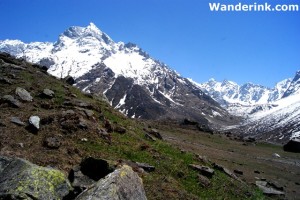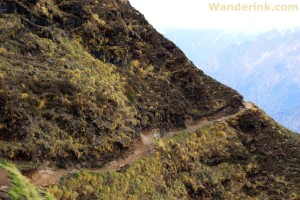The trek was meant to be bonding time for Anirban and Amitav, father-son. They were understandably gung-ho and impressively geared up: Maui Jim glasses, supplex trousers, backpacks and shoes from North Face, imported granola bars and water purifying tablets, other Nike and Protrek works. Anirban headed a platoon guarding the Indian border with Pakistan along Siachen – planning to the last detail was everyday. Nothing was overlooked.
To prepare for the trek, Anirban drew from his own experience as a high altitude ranger as well as from the numerous how-tos that stumble out from a stab at the internet. They are the last word in what to pack and how, when to go and where, some even recommends SPFs. But out there, there are many more issues seldom addressed by these expertspeaks: Is distributing candies callous to environment? The ethicality of doling out medicines to mountain folk even if they rend you with their symptomatic litanies. Should money be given to children? Once a fellow trekker found himself in a potentially inflammable situation by giving a high denomination note to a teenager who decided to angle for more.
Go by the grading; the scenery is everywhere
“Who graded this trek ‘moderate’?” One disgruntled trekker barked at the guide. It was just the end of day one.
“This trek should actually be clubbed with the ‘tough’ treks. Even as a ‘super tough’ one,” opined another who managed to crawl into camp on all fours.
“Sir this is actually an ‘easy’ one going by the distance covered and the nature of the terrain,” replied the guide, nonchalantly. The other two looked at each other nonplussed at the hint of insouciance in the courteous, almost-servile guide. The unfortunate fact in the exchange here was that all the parties were right well, in their own right. But what lends more marrow to the bone of contention, the grading levels, is that fitness levels – which vary vastly, diametrically among Indians – are not factored in.
While in advanced trekking parlance there are levels one to six, in India we generally use simpler nomenclature – easy, moderate and difficult. Some outdoor companies even throw in a ‘moderate plus’ between moderate and difficult which further compound the conundrum. Easy is usually five hours’ walk with one hour of climb per day; moderate involves more than five hours’ walking – about 10 kilometres while difficult ones cover anywhere between 15 to 30 kilometres through at times treacherous terrains. (From my experience and the definitions, I am assuming ‘moderate plus’ ones to be above 10 but less than 15 kilometres.)
Many chose a particular trek because they ‘heard the name from friends’ or ‘seen really wonderful photographs’ – both non-reasons as trekking generally involves walking through really pretty landscapes. Even if you decide to go by your own reasons, then make sure you understand the grade assigned to the trek: Talk to the organisers, discuss on forums, or do a spot of secondary research and find out what kind of distances and terrain each day entails. Whether to brag or be a beacon for the next one, most trekkers keep a blog these days.
And decide if you are up to it.
Are you up to it? It’s not all in the mind
His toes were blistered up like chemical froth and he winced in pain while taking off his shoes after the very first day of the trek.
“I just have no idea how this happened,” he said unbelieving. “This is a brand new pair of *beeps out brand name* shoes.”
“I learnt how it happens when I got my first pair of Lotto running shoes while in school.” Though I wanted to tell him I didn’t taking pity on his lugubrious situation. But this was not the first time I was seeing somebody suffer because he tried to break a new pair of shoes while on the trail! New gear is definitely a necessity for those getting started so it is – and an incentive too – for the seasoned ones to push farther or climb higher. But buying a new pair of shoes on the eve of departure is hardly the way to go and mars your chances of completing the trek even. The other one that comes in the way is fitness.
A couple of annual treks, each lasting for about a week, is the sole physical exercise for a painter friend and he completes too without any fuss. At the end of each day he can be found at the most scenic corner, puffing away, outlining in mind his next canvas. He says it’s all in the mind. Yes and Hidalgo completed the run! I have seen people drop with all the longevity of a Luna moth, first day, first hour into the trek. Like Amitav, despite the scintillating array of gadgets and gear. What Anirban overlooked was his boy’s physical condition. As a rule of thumb if you intend to undertake any trek – regardless of the grading – that lasts anywhere up to a week then you should prepare for at least two months. Jogging and running are just one; there is abundant material on the internet on how to go about it.
There is nothing wrong with the way treks are graded; what’s wrong is with the way you look at it.
Change the way you look. By changing your outlook
“Bhaiya, thoda maalish-waalish karoge?” (“Brother, can you do me a massage?’) The guy asked the camp cook, limping into the site. A silence like one enforced by a sledgehammer fell upon everybody.
“Kuch paisa-waisa bhi le lo.” (“Take some money too.”) The limping lout continued unable to fathom what hit the rest of us. Though soon somebody pointed out that these guys were support staff with an adventure company and not masseurs at a grooming saloon the cook – till then an irreverent, garrulous storyteller – just sat there glowering, sullen and silent. The spark was missing the rest of the trek. Though such morons are everywhere – the same guy later demanded carom boards and television sets where even sunlight struggled through – please do remember that the guides and cooks are not our Man Fridays but professionals in their own spheres who should be treated with respect.
Respect your knowledge. And lack of it
“Give your baby these Paracetamol tablets, he will be fine.” A fellow trekker said doling out a few electric blue strips of the popular panacea for everything from headache to heartache to a village woman who came to our camp with a snotty, somnambulant issue. The trekker was no doctor but was playing one. When I told him that even today my mom brings the house down if I took a 500 milligram Paracetamol he replied the mountain folks are a hardy lot. I wondered aloud whether I heard right when he said he dealt in imported jewellery; maybe he really was an apothecary.
While it is indeed true that none of these remote mountain hamlets have even a basic dispensary, it is not for the trekker passing by to dispense prognosis and prescription medicines, not even prophylactic ones. At Osla in interior Uttarkhand, some youngsters had discovered the highs, courtesy of copious quantities cough syrup; a village elder repeatedly requested trekkers not to hand out medicines individually to villagers. If you have to distribute medicines do give it to the village mukhiya, the headman, or the local school teacher, who can at least ensure it is not gobbled up or gulped down.
As mountain villages clear their way to the zenith, what is left behind are plastic mounds, remnants of the sachet economy, clogging streams and choking hills. Though you don’t have to take the same measures with candies as you should with medicine, you could do a world of good by not handing out individually wrapped sweets; instead buy a large candy bar, divide it and distribute. You are bound to touch an unhappy nerve here with the runny-nosed rag tag: “Gimme the whole thing,” demanded one. But look at it this way: The plastic you make them discard is the plastic you discard yourself.
NB: Sharing the tenets of Leave No Trace with the elfin bunch will reach you nowhere beyond ‘this weirdo’ sniggers.

















Very informative and excellent write-up Thommen.Always wondered about the amount of preparation/training that goes into a trek depending on the difficulty as well as the fitness level.
Thank you very much. Thought it was about time somebody spoke about what was NOT in those trekking manuals and organiser websites.
Very interesting information here ! Responsible and eco – friendly traveling is the necessity of the day.
Very good opening to the avid adventurer in each of us. Thanks Thommen we know how to start.
My pleasure, Sasi. I picked it up from the trail only; thought would save others the trouble 🙂